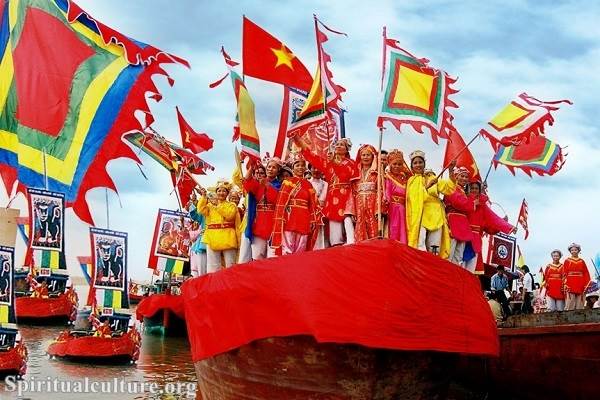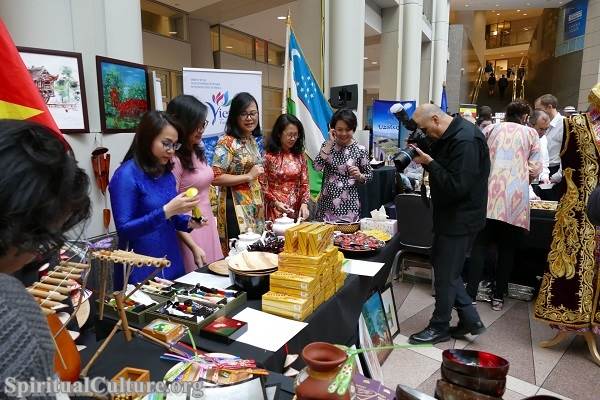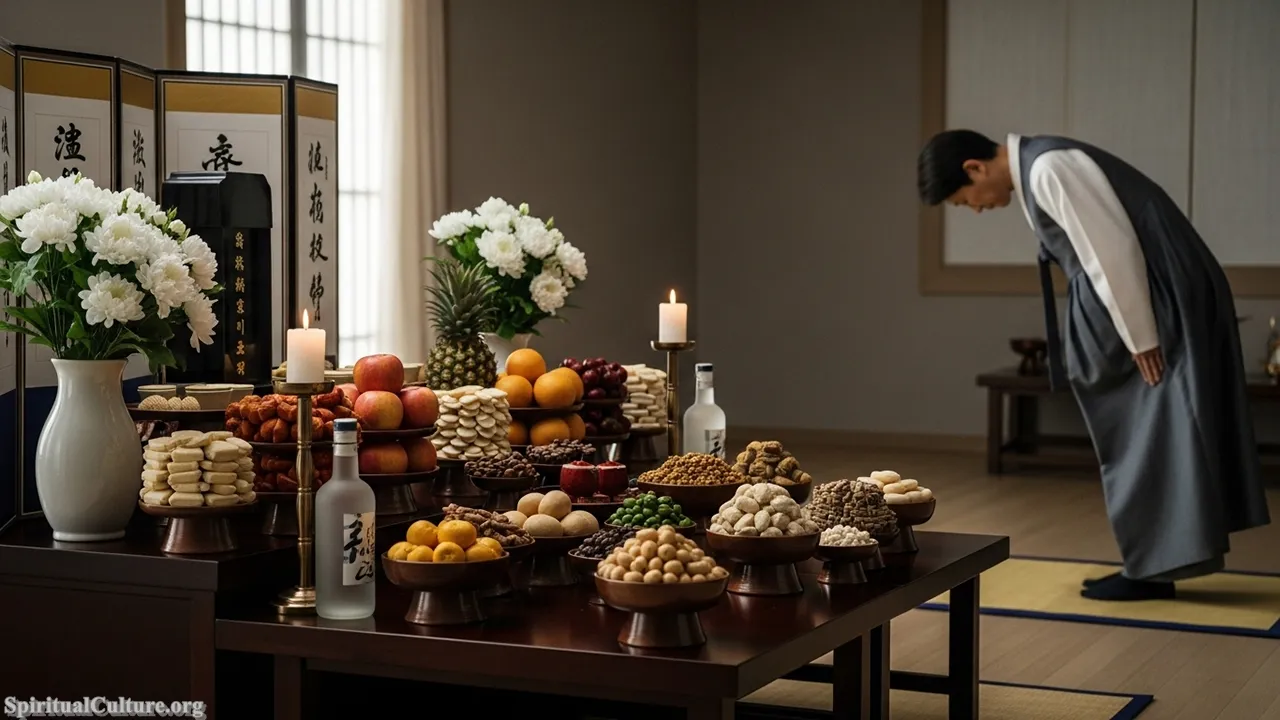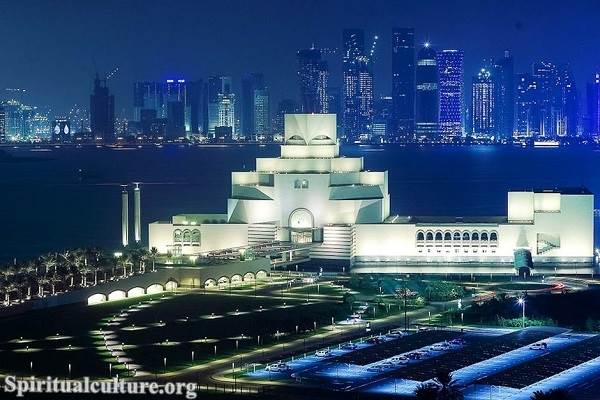Japan is often described as the land of Yaoyorozu no Kami—eight million gods. It is a nation where the indigenous spirituality of Shinto and the imported profundity of Buddhism have not only coexisted but intertwined for over a millennium, creating a unique spiritual landscape known as Shinbutsu-shugo. At Spiritual Culture, we believe that visiting these ancient sites is not merely a sightseeing excursion; it is a pilgrimage into the soul of a civilization that honors nature, ancestors, and the silence between thoughts.
To select the “Top 10 Most Historic,” we moved beyond simple popularity or visual appeal. We analyzed historical antiquity, the magnitude of religious influence, the preservation of ancient rituals, and the depth of their spiritual legacy current as of the Current Time of Writing. From the “Mother Mountain” of Japanese Buddhism to the primeval forests where the Sun Goddess dwells, this list represents the absolute zenith of Japanese heritage.
The following ranking invites you to step across the threshold of the Torii and the Sanmon gate. We explore why these specific sites have commanded the reverence of Emperors, Shoguns, and millions of pilgrims for centuries, and what moral or spiritual lessons they continue to whisper to the modern world today.
Table of the Top 10 Historic Temples and Shrines with the Greatest Spiritual Influence
| Rank | Name of Site | Location | Affiliation | Founding Era / Date | Primary Deity / Figure |
|---|---|---|---|---|---|
| 1 | Ise Jingu (The Grand Shrine of Ise) | Mie Pref. | Shinto | ~4 BCE (Traditional) | Amaterasu Omikami |
| 2 | Horyu-ji Temple | Nara Pref. | Buddhism | 607 CE | Prince Shotoku / Yakushi Nyorai |
| 3 | Izumo Taisha (Izumo Grand Shrine) | Shimane Pref. | Shinto | Ancient (Age of Gods) | Okuninushi no Okami |
| 4 | Todai-ji Temple | Nara Pref. | Buddhism | 728 CE | Vairocana Buddha (Daibutsu) |
| 5 | Koyasan (Okunoin) | Wakayama Pref. | Buddhism (Shingon) | 816 CE | Kobo Daishi (Kukai) |
| 6 | Enryaku-ji (Mt. Hiei) | Kyoto/Shiga | Buddhism (Tendai) | 788 CE | Saicho / Yakushi Nyorai |
| 7 | Itsukushima Shrine | Hiroshima Pref. | Shinto | 593 CE (Origins) | Three Munakata Goddesses |
| 8 | Kiyomizu-dera | Kyoto Pref. | Buddhism (Kita-Husso) | 778 CE | Kannon Bodhisattva |
| 9 | Fushimi Inari Taisha | Kyoto Pref. | Shinto | 711 CE | Inari Okami |
| 10 | Senso-ji | Tokyo | Buddhism | 628 CE | Kannon Bodhisattva |
Top 10. Senso-ji (Tokyo)
While Tokyo is often viewed as a futuristic metropolis, its spiritual heart beats anciently at Senso-ji. Legend holds that in 628 CE, two fishermen pulled a golden statue of Kannon, the Bodhisattva of Mercy, from the Sumida River. Despite their attempts to return it to the water, the statue returned to them, leading to the temple’s founding. It is the oldest temple in Tokyo, surviving the firebombings of WWII to rise again as a symbol of the city’s resilience. The iconic “Kaminari-mon” (Thunder Gate) serves as the border between the commercial world and the sacred precincts.
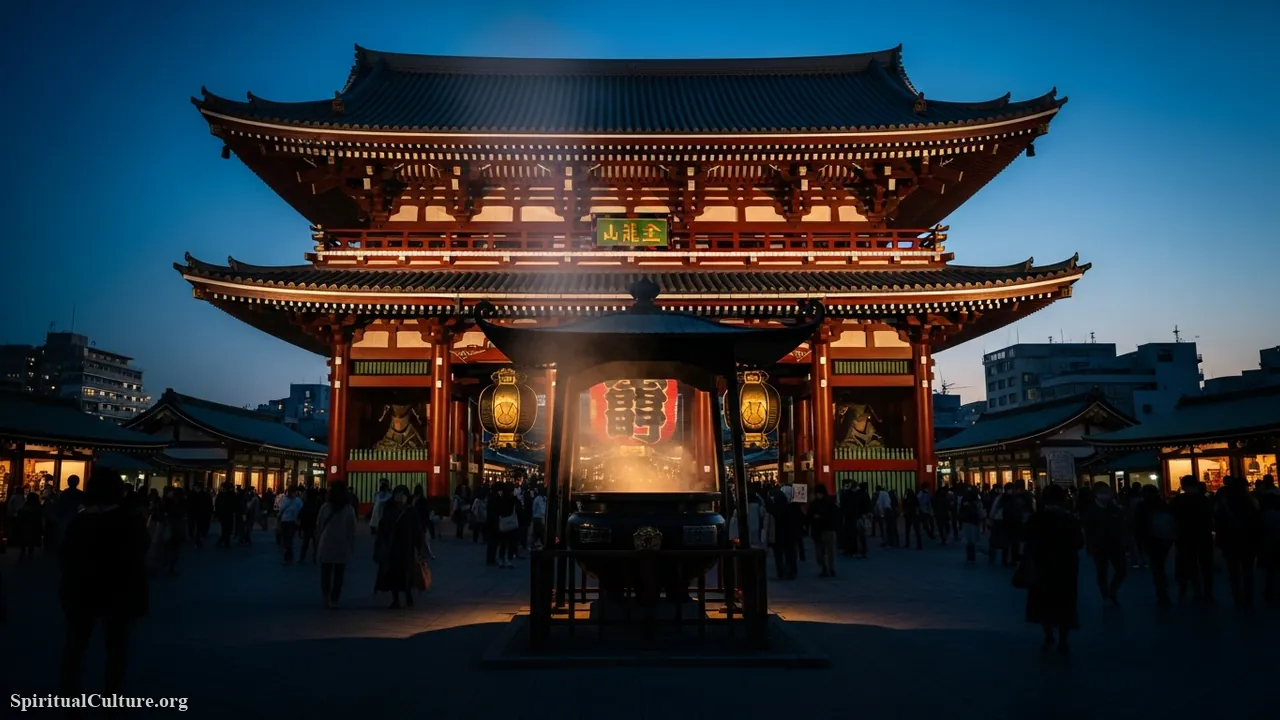
Senso-ji ranks in our Top 10 not just for its age, but because it represents the “Buddhism of the Common People” (Shomin-shinko). Unlike the aristocratic temples of Kyoto, Senso-ji has always been accessible to the masses, fostering a vibrant culture where commerce and spirituality mix freely along the Nakamise-dori. The “Hibutsu” (Hidden Buddha) tradition—where the main image is never shown to the public—generates a powerful aura of mystery. Millions visit to waft the healing smoke of the incense burner (jokoro) over their bodies, seeking physical and spiritual purification.
Senso-ji teaches us that the sacred can exist amidst the noise of daily life. It is a testament to the idea that mercy (Kannon) is available to everyone, regardless of status. The preservation of the hidden statue for over 1,400 years reminds us that true spiritual power does not need to be seen to be felt; faith is the act of believing in the invisible benevolence that guides us.
Cultural & Spiritual Highlights
- The Hidden Buddha: The central statue of Kannon has remained strictly hidden from public view for centuries, enhancing its mystical authority.
- O-mikuji Tradition: Senso-ji is famous for its strict fortune-telling strips; drawing a “Bad Luck” fortune here is considered a genuine opportunity for caution and course correction.
- The Lantern: The massive red lantern at the gate weighs 700kg and was donated by Panasonic founder Konosuke Matsushita as a prayer for healing.
Top 9. Fushimi Inari Taisha (Kyoto)
Established in 711 CE, predating the capital’s move to Kyoto, Fushimi Inari is the head shrine for some 30,000 Inari shrines across Japan. Inari is the deity of rice, agriculture, and by extension, business and prosperity. The shrine sits at the base of Mount Inari, and the entire mountain is considered sacred ground. While famous globally for its vermilion Senbon Torii (Thousands of Torii Gates), its history is deeply rooted in the agrarian cycles of planting and harvest that defined early Japanese civilization.
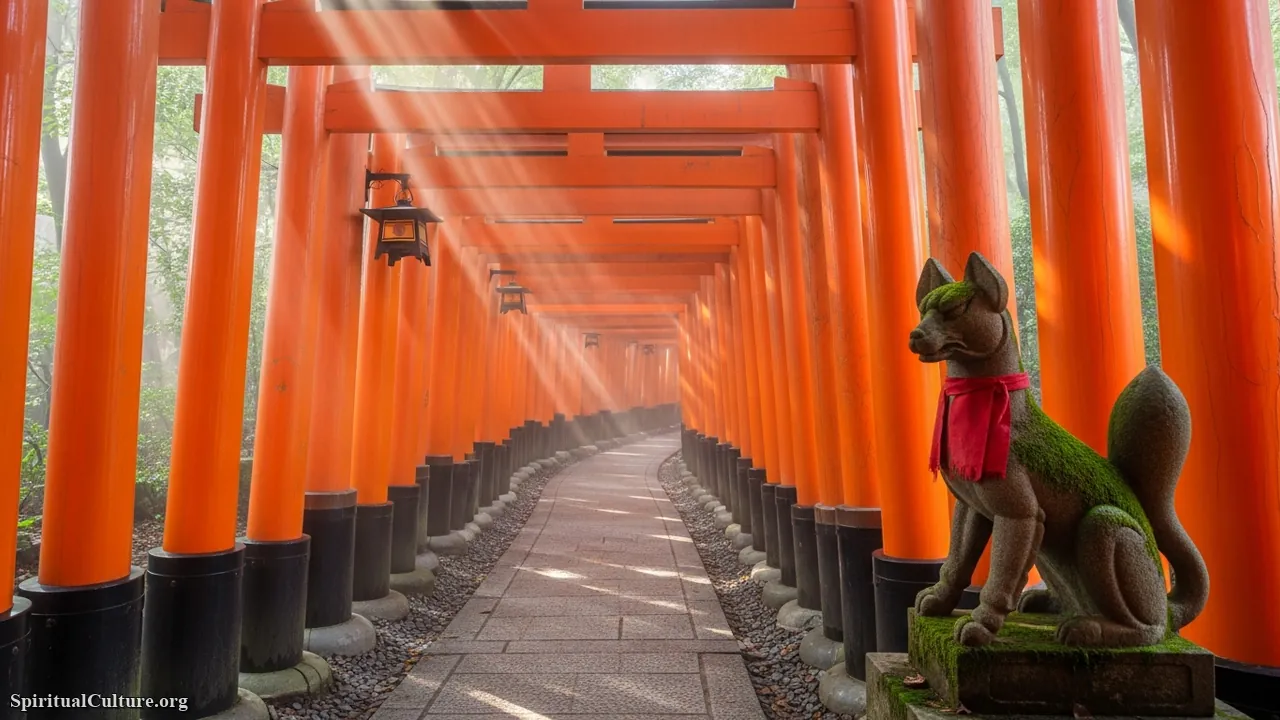
The spiritual impact of Fushimi Inari is best experienced not at the crowded base, but during the Oyama-meguri—the pilgrimage hike up the mountain. Each Torii gate represents a donation of gratitude from a business or individual, creating a physical tunnel of human thankfulness stretching back centuries. This shrine represents the vital connection between spiritual gratitude and worldly success. It is a place where the material and the spiritual are not seen as enemies, but as partners in a prosperous life.
At Spiritual Culture, we see Fushimi Inari as a reminder of “Gratitude in Action.” The endless rows of gates are visual proof of prayers answered and thanks given. It teaches us that prosperity is not just about accumulation, but about acknowledging the divine source of our sustenance. The fox messengers (Kitsune) remind us of the playful yet serious nature of the spirits guarding the harvest.
Cultural & Spiritual Highlights
- Senbon Torii: A vortex-like tunnel of over 10,000 vermilion gates, symbolizing the passage from the mundane to the sacred.
- Fox Statues: You will see foxes holding keys (to the rice granary) or scrolls (wisdom), acting as the messengers of the Inari deity.
- Mountain Pilgrimage: The full 4-kilometer loop up the mountain offers a profound meditative experience often missed by tourists who stay at the bottom.
Top 8. Kiyomizu-dera (Kyoto)
Founded in 778 CE, before Kyoto became the capital, Kiyomizu-dera (“The Temple of Pure Water”) is inextricably linked to the Otowa Waterfall. The temple belongs to the Kita-Hosso sect and is dedicated to the Eleven-Headed Kannon. Its massive wooden stage, jutting out over the hillside without the use of a single nail, is a marvel of ancient engineering and a UNESCO World Heritage site. Throughout history, it has been a destination for pilgrims seeking the “pure water” believed to grant longevity, success, and love.
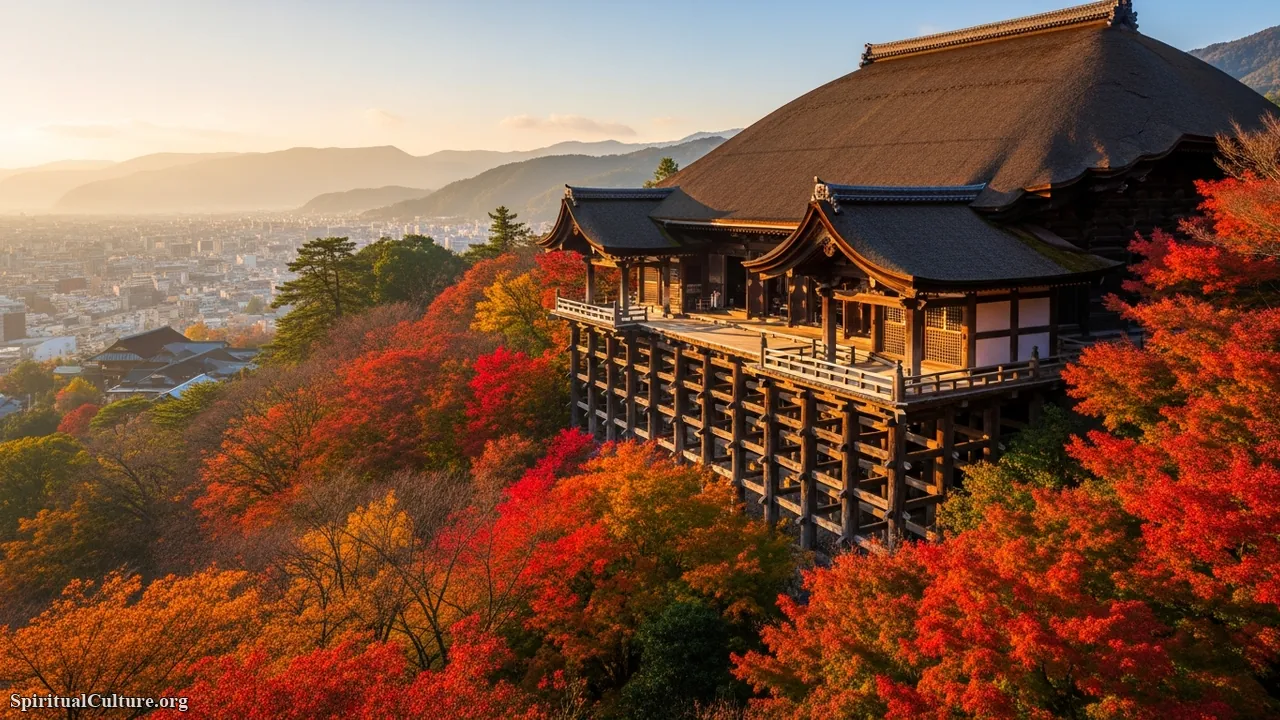
Kiyomizu-dera captures the essence of “Spiritual Purity.” The temple is built around the waterfall, signifying that faith begins with cleansing the mind and body. The spiritual concept here is Kannon’s Mercy—the idea that the Bodhisattva hears the cries of the suffering world. The famous phrase “jumping off the stage of Kiyomizu” reflects a historical practice of committing one’s life to the Buddha (though now it serves as a metaphor for making bold decisions).
The temple teaches the lesson of Harmony with Nature. The architecture does not dominate the mountain; it extends from it, supported by massive zelkova pillars. It reminds us that spiritual structures should support and elevate us, much like the great stage supports the throngs of visitors. The three streams of the waterfall invite us to choose our desires wisely—drinking from all three is considered greedy, a subtle lesson in moderation.
Cultural & Spiritual Highlights
- Otowa Waterfall: Visitors catch water from three streams representing longevity, success, and love; drinking from all three is discouraged as a sign of greed.
- The Wooden Stage: A 13-meter high structure built without nails, offering a panoramic view that connects the pilgrim to the vastness of the world below.
- Jishu Shrine: Located within the complex, this shrine to the deity of love features “love stones” that visitors must walk between with their eyes closed to ensure romantic success.
Top 7. Itsukushima Shrine (Hiroshima)
Located on the island of Miyajima, where the land itself was considered so sacred that commoners were historically forbidden to set foot on it, Itsukushima Shrine is built over the water to avoid “defiling” the island. While its origins date to 593 CE, its current Shinden-style grandeur was established by the powerful warlord Taira no Kiyomori in the 12th century. It is a Shinto sanctuary dedicated to the three Munakata goddesses of the sea and storms.

Itsukushima is the supreme example of Shinto’s aesthetic of purity and liminality. The famous “Floating Torii” gate marks the boundary not just between the sea and the shrine, but between the human world and the divine realm. At high tide, the shrine appears to float, suggesting that the divine is fluid, rising and falling with the natural rhythms of the ocean. It is a place of profound aesthetic spirituality, where beauty itself is a form of worship.
This site teaches us about Adaptability and Flow. The shrine is designed to survive the tides and typhoons; its floorboards have gaps to alleviate water pressure. It is a powerful architectural metaphor for resilience—allowing the forces of nature to pass through us rather than breaking against them. It stands as a testament to the Japanese ability to find the sacred in the shifting tides of existence.
Cultural & Spiritual Highlights
- The Floating Torii: One of Japan’s most iconic views; the gate is not buried in the seabed but stands by its own weight, balancing nature and architecture.
- Purification by Tides: The rising tide symbolically purifies the shrine daily, reinforcing the Shinto focus on cleanliness and renewal.
- Noh Stage: The oldest Noh stage in Japan floating on the sea, where performances were offered to the gods, not human audiences.
Top 6. Enryaku-ji (Mt. Hiei)
Perched atop Mount Hiei guarding the northeast (demon’s gate) of Kyoto, Enryaku-ji was founded in 788 CE by the monk Saicho. It is the headquarters of the Tendai sect and is historically the most influential monastery in Japan. Known as the “Mother Mountain of Japanese Buddhism,” almost all founders of later major sects (Pure Land, Zen, Nichiren) studied here. For centuries, it possessed a fearsome army of warrior monks, making it a political powerhouse until warlord Oda Nobunaga burned it down in 1571; it was later rebuilt to its solemn glory.
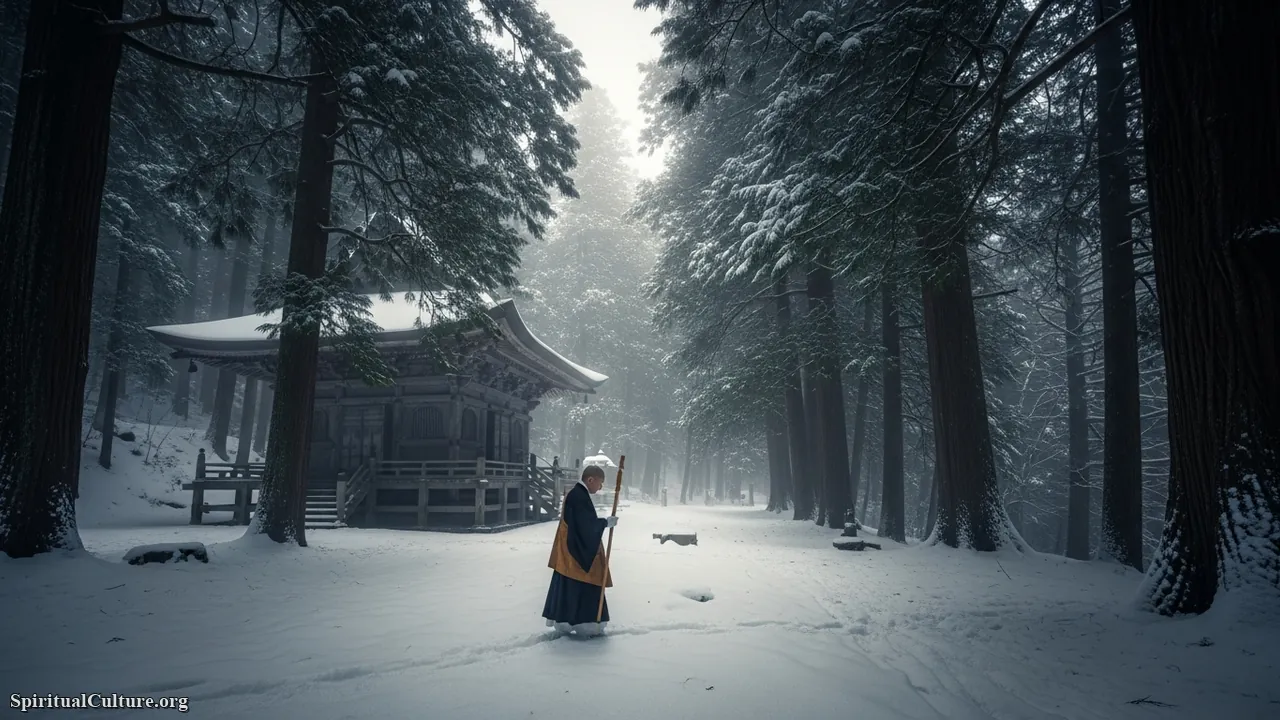
Enryaku-ji represents Ascetic Rigor and Academic Depth. It is the home of the “Marathon Monks” (Kaihogyo), who undertake a 1,000-day walking meditation over seven years—a feat of physical and spiritual endurance unmatched globally. The temple radiates a severe, disciplined spirituality. It is not a place of comfort, but of intense training and the relentless pursuit of enlightenment. The “Eternal Light” in the main hall has burned for 1,200 years, symbolizing the undying light of the Dharma.
Enryaku-ji teaches the value of Discipline and Lineage. It reminds us that spiritual growth often requires leaving the comforts of the city (Kyoto) and ascending the mountain of difficulty. The preservation of the Eternal Light reminds us that it takes constant vigilance and effort to keep the flame of wisdom alive in a dark world.
Cultural & Spiritual Highlights
- The Eternal Light: An oil lamp in the Konpon Chudo hall that has remained lit for 1,200 years, representing the light of the Buddha’s teachings.
- Kaihogyo (Marathon Monks): The ultimate ascetic practice involving walking 40,000km over 1,000 days; failing the practice historically meant ritual suicide (though this is no longer enforced, the gravity remains).
- Mother of Sects: The intellectual birthplace of the founders of Zen (Eisai/Dogen), Pure Land (Honen/Shinran), and Nichiren Buddhism.
Top 5. Koyasan (Okunoin)
Founded in 816 CE by the legendary monk Kukai (Kobo Daishi), Mount Koya is the center of Shingon Esoteric Buddhism. Sitting in a basin surrounded by eight peaks resembling a lotus flower, it is a secluded religious city. The heart of Koyasan is Okunoin, Japan’s largest cemetery, stretching 2km through ancient cedars to the mausoleum of Kobo Daishi. Legend says Kukai is not dead but in eternal meditation (nyujo), awaiting the Future Buddha, Maitreya.
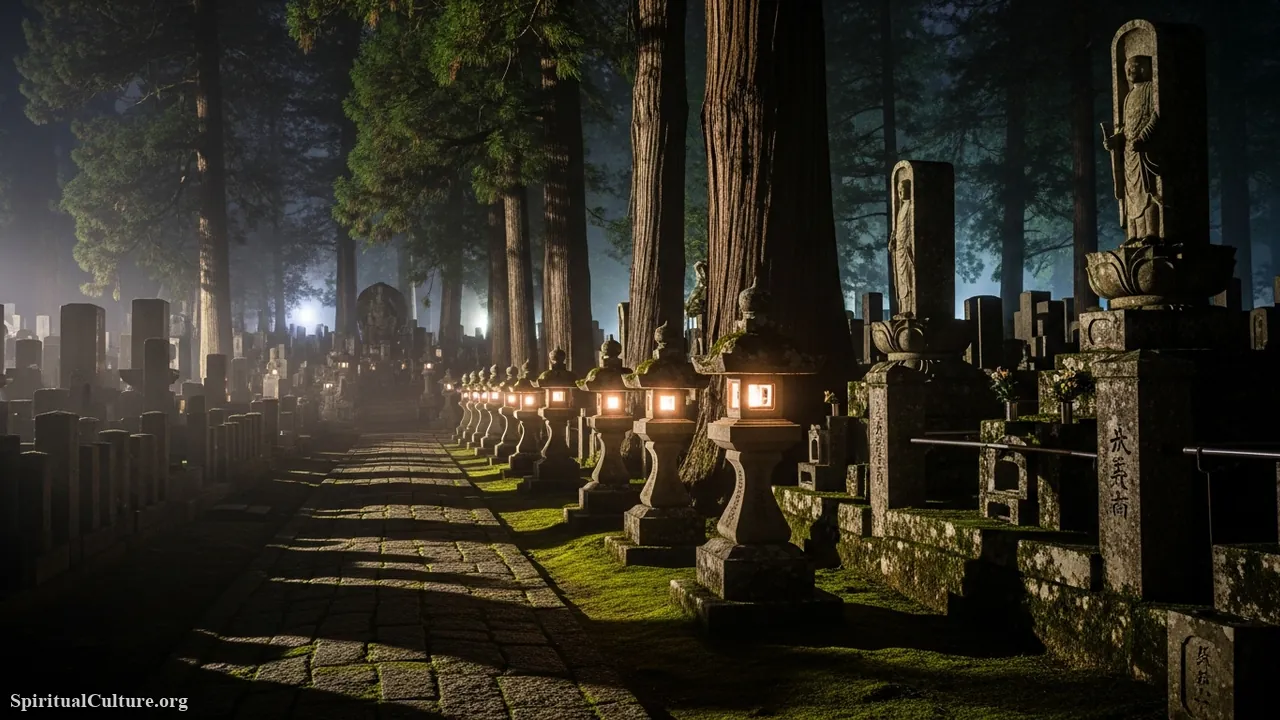
Koyasan offers perhaps the most atmospheric spiritual experience in Japan. Walking through Okunoin is a journey through Japanese history; gravestones of samurai warlords, corporate giants, and commoners sit side-by-side in the mossy forest. The spiritual impact here is the Transcendence of Death. In Shingon belief, death is not an end but a transition. The ritual of monks bringing meals to Kukai’s mausoleum twice daily for 1,200 years creates a palpable sense of the “living presence” of the master.
Koyasan teaches Inclusivity in Death. Enemy warlords who fought in life are buried yards apart in Okunoin, reconciled by the peace of the Buddha. It is a profound lesson in ultimate forgiveness and the equality of all souls. The towering cedar trees, some nearly 1,000 years old, serve as living pillars of this natural cathedral, urging us to respect the silence.
Cultural & Spiritual Highlights
- Kobo Daishi’s Mausoleum: The site where Kukai is believed to be in eternal meditation; it is considered one of the holiest spots in Japan.
- Torodo (Hall of Lamps): A hall containing over 10,000 lanterns, including one said to have been burning for 900 years, offered by a poor woman who sold her hair to buy it.
- Esoteric Rituals: Visitors can experience Goma fire rituals, where sticks representing human desires are burned to invoke wisdom.
Top 4. Todai-ji (Nara)
Constructed in 752 CE under Emperor Shomu, Todai-ji was the centerpiece of a national project to use Buddhism to protect the state from disasters and plagues. Its Great Buddha Hall (Daibutsuden) is one of the world’s largest wooden buildings, housing the colossal bronze statue of Vairocana Buddha (the Cosmic Buddha). The construction was a massive undertaking that nearly bankrupted the ancient Japanese economy but successfully united the populace in a shared spiritual cause.

Todai-ji ranks highly due to its Scale of Vision. The Great Buddha (Daibutsu) represents the universe itself—Vairocana is the sun, the source of all existence. Standing before the 15-meter statue, one feels the overwhelming magnitude of the Buddhist cosmology. It was built with the donations of over 2.6 million people (half the population at the time), making it a monument to collective spiritual will and national unity.
Todai-ji serves as a reminder of Interconnectedness. Emperor Shomu declared that even a single blade of grass or a handful of earth contributed to the project was a holy act. It teaches us that great spiritual achievements are not the work of one leader, but the result of the collective heart of the people. The statue’s hand is raised in a gesture of “Fear Not,” a timeless message of comfort.
Cultural & Spiritual Highlights
- The Daibutsu: The world’s largest bronze statue of the Buddha Vairocana, symbolizing the light of truth shining on all beings.
- Nigatsu-do Hall: Famous for the Omizutori (Water Drawing) festival, a fire and water ritual performed annually since 752 CE without a single break.
- The Pillar with a Hole: A supporting pillar with a hole the same size as the Daibutsu’s nostril; squeezing through it is said to grant enlightenment in the next life.
Top 3. Izumo Taisha (Shimane)
Izumo Taisha is shrouded in the mists of the “Age of the Gods.” It is dedicated to Okuninushi, the deity of nation-building and medicine, who ceded the land to the ancestors of the Imperial family. Unlike Ise, which deals with the visible world and politics, Izumo governs the unseen world—fate, relationships, and the afterlife. It is famed for its massive Shimenawa (sacred straw rope) weighing several tons, symbolizing the boundary between the mundane and the divine.
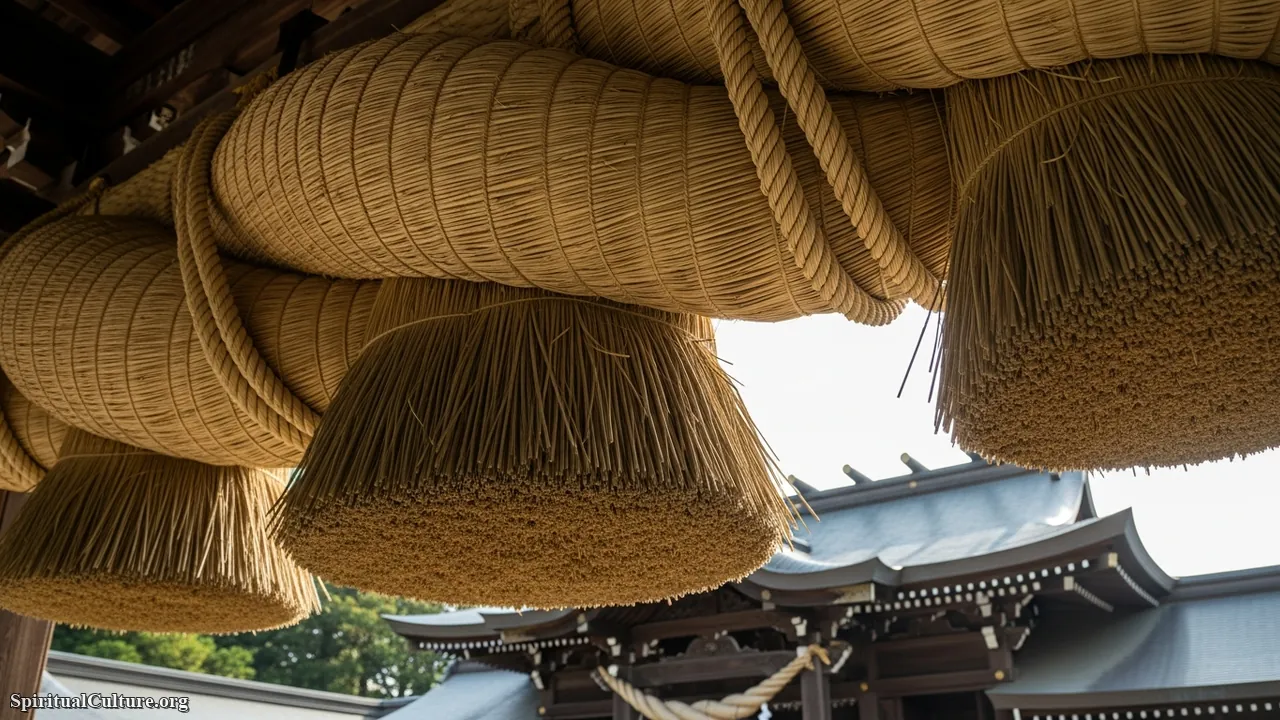
Izumo Taisha holds the unique status of being the Meeting Place of the Gods. In the 10th lunar month (usually November), it is believed that all 8 million gods of Japan leave their local shrines and gather at Izumo to discuss the destiny and relationships (En-musubi) of all humans for the coming year. This gives Izumo a gravity and density of spiritual power found nowhere else. It is the ultimate shrine for praying for good connections—not just romantic, but business and friendships.
Izumo teaches the value of Surrender and Trust. The myth of Okuninushi ceding the land peacefully teaches that true strength lies in negotiation and benevolence, not just war. The massive architecture, which ancient records suggest was once a skyscraper of wood reaching into the clouds, reflects the human desire to bridge the gap between earth and the heavens.
Cultural & Spiritual Highlights
- Kamiari-zuki: While the rest of Japan calls October “The Month Without Gods,” in Izumo it is “The Month With Gods,” marked by solemn festivals.
- The Giant Shimenawa: A straw rope weighing 5 tons; standing beneath it emphasizes the weight and importance of the sacred bond.
- Four Claps: Unlike the standard two claps at other shrines, visitors here clap four times: twice for themselves and twice for their partner (or future connections).
Top 2. Horyu-ji (Nara)
Founded in 607 CE by Prince Shotoku, the “father of Japanese Buddhism,” Horyu-ji contains the oldest surviving wooden structures in the world. Prince Shotoku is a figure of immense cultural weight, credited with writing Japan’s first constitution and embedding Buddhist ethics into the government. Horyu-ji was the laboratory where Japanese culture fused with continental Asian philosophy, creating the foundation for the civilization that followed. It was Japan’s first UNESCO World Heritage site.
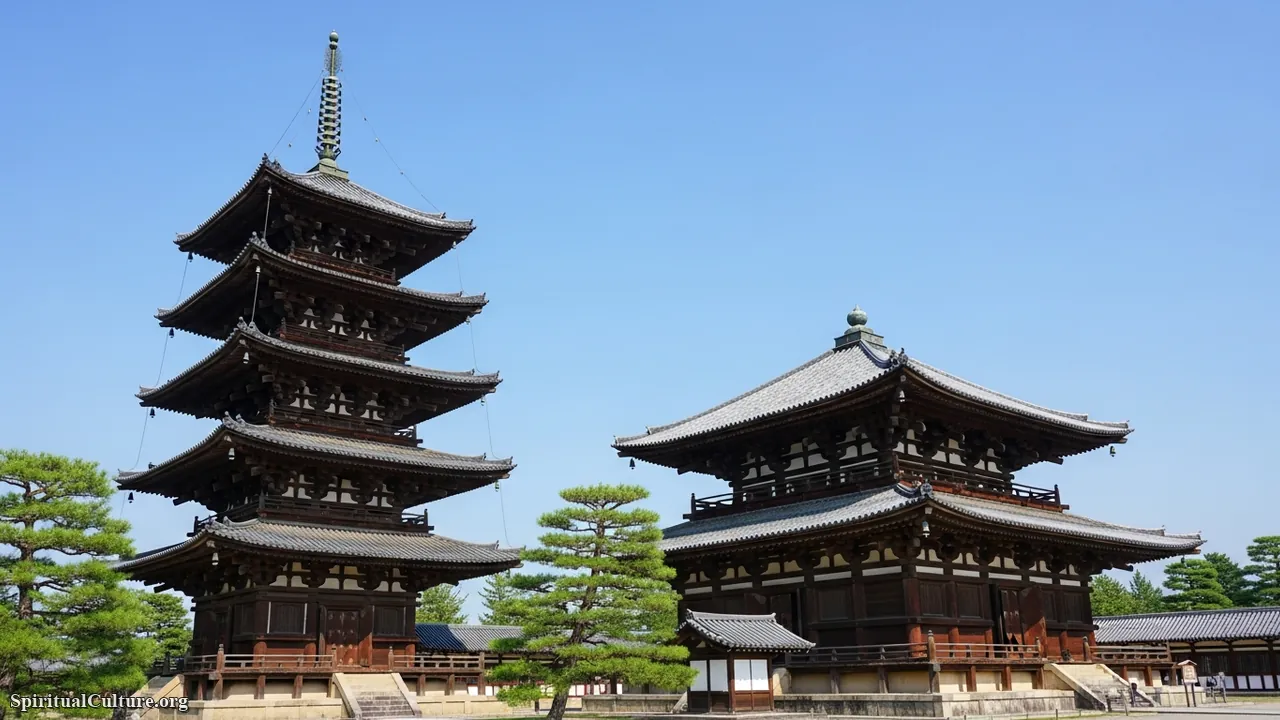
Horyu-ji is the Time Capsule of the Spirit. Walking through its Western Precinct is literally walking through the 7th century. The spiritual impact here is intellectual and foundational; this is where the “Wa” (Harmony) discussed in the 17-Article Constitution was born. The serene smile of the Kudara Kannon and the archaic beauty of the Five-Story Pagoda transport visitors back to the dawn of Japanese faith. It represents the scholarly and ethical side of Buddhism.
Horyu-ji stands as a monument to Resilience and Wisdom. The fact that wood—a perishable material—has sustained these structures for 1,400 years is a miracle of craftsmanship and maintenance. It teaches us that if we build with integrity and maintain with care (both structures and our own characters), we can withstand the ravages of time.
Cultural & Spiritual Highlights
- Oldest Wooden Buildings: The Main Hall (Kondo) and Five-Story Pagoda are the world’s oldest, surviving earthquakes for over a millennium.
- Yumedono (Hall of Dreams): Built on the site where Prince Shotoku is said to have meditated and received visions.
- Guze Kannon: A mysterious statue hidden for centuries, revealed in the Meiji era, possessing an archaic “smile of mystery” unlike any other in Japan.
Top 1. Ise Jingu (Mie)
At the pinnacle of our list is Ise Jingu, simply known as Jingu (The Shrine). It is the spiritual home of the Japanese people. Dedicated to Amaterasu Omikami (the Sun Goddess), the mythical ancestor of the Imperial family, its origins are legendary, dating back 2,000 years. It consists of the Inner Shrine (Naiku) and Outer Shrine (Geku). The most profound aspect of Ise is the Shikinen Sengu: every 20 years, for the past 1,300 years, the shrine buildings are completely rebuilt from scratch on an adjacent lot, transferring the deity to the new home.
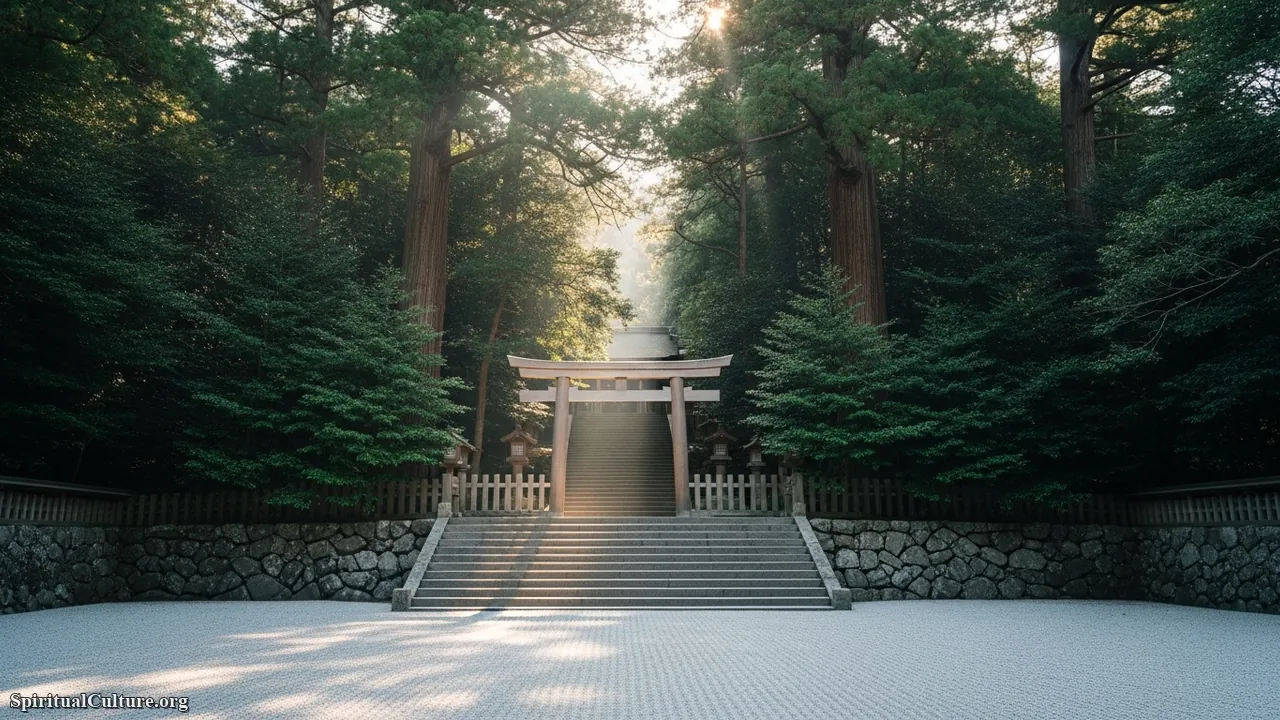
Ise Jingu is the embodiment of Eternal Renewal and Purity. It is the holiest site in Shinto because it does not worship “old” things; through the 20-year rebuilding cycle, the shrine is always new, yet ancient. This paradox represents the Shinto view of nature: always changing, yet always the same. The atmosphere at Ise is overwhelming in its simplicity—unpainted cypress wood, white gravel, and deep green forests. There are no idols to see; visitors pray before a white curtain, feeling the presence of the divine in the wind and trees.
Ise Jingu teaches the ultimate lesson of Impermanence and Continuity. We do not preserve tradition by freezing it in stone, but by actively participating in its renewal. The skills required to build the shrine are passed down from generation to generation, ensuring the culture survives, not just the building. It is a place that strips away the ego, leaving only a sense of gratitude for the sun that nourishes all life.
Cultural & Spiritual Highlights
- Shikinen Sengu: The ritual rebuilding every 20 years (next in 2033) ensures the shrine remains eternally young and pure (Tokowaka).
- Yata no Kagami: The Inner Shrine houses the Sacred Mirror, one of the three Imperial Regalia, said to embody the Sun Goddess herself (never seen by the public).
- Uji Bridge: Crossing this wooden bridge over the Isuzu River is considered the transition from the profane world to the sacred realm of the Kami.
Conclusion
In compiling this list of the Top 10 Most Historic Temples and Shrines, Spiritual Culture recognizes that the true value of these sites lies not in their wood and stone, but in the continuity of the human spirit they represent. From the towering bronze of Todai-ji to the silent forests of Ise, these locations are anchors of identity.
They remind us that we are part of a lineage of faith that stretches back thousands of years. Whether it is the Shinto gratitude for nature or the Buddhist compassion for suffering, the lessons embedded in these sites are timeless. We encourage you to visit not just as a tourist with a camera, but as a pilgrim with an open heart. In the silence of these sacred grounds, you may find that the history being told is not just Japan’s, but a chapter of the universal human search for meaning.
